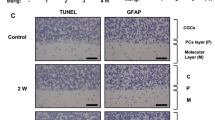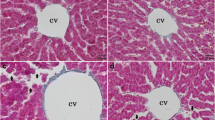Abstract
In this study we examined the possible antigenotoxic effect of selenium (Se) in rats chronically exposed to low levels of methylmercury (MeHg) and the association between glutathione peroxidase (GSH-Px) activity and DNA lesions (via comet assay) in the same exposed animals. Rats were divided into six groups as follows: (Group I) received water; (Group II) received MeHg (100 μg/day); (Group III) received Se (2 mg/L drinking water); (Group IV) received Se (6 mg/L drinking water); (Group V) received MeHg (100 μg/day) and Se (2 mg/L drinking water); (Group VI) received MeHg (100 μg/day) and Se (6 mg/L drinking water). Total treatment time was 100 days. GSH-Px activity was determined spectrophotometrically and DNA damage was determined by comet assay. Mean GSH-Px activity in groups I, II, III, IV, V and VI were, respectively: 40.19 ± 17.21; 23.63 ± 6.04; 42.64 ± 5.70; 38.50 ± 7.15; 34.54 ± 6.18 and 41.39 ± 11.67 nmolNADPH/min/gHb. DNA damage was represented by a mean score from 0 to 300; the results for groups I, II, III, IV, V and VI were, respectively: 6.87 ± 3.27; 124.12 ± 13.74; 10.62 ± 3.81; 13.25 ± 1.76; 86.87 ± 11.95 and 76.25 ± 7.48. There was a significant inhibition of GSH-Px activity in group II compared with group I (P < 0.05). Groups V and VI did not show a difference in enzyme activity compared with groups III and IV, showing the possible protective action of Se. Comet assay presented a significant difference in DNA migration between group II and group I (P < 0.0001). Groups V and VI showed a significant reduction in MeHg-induced genotoxicity (P < 0.001) when compared with group II. A negative correlation (r = −0.559, P < 0.05) was found between GSH-Px activity and DNA lesion, showing that the greater the DNA damage, the lower the GSH-Px activity. Our findings demonstrated the oxidative and genotoxic properties of MeHg, even at low doses. Moreover, Se co-administration reestablished GSH-Px activity and reduced DNA damage.

Similar content being viewed by others
References
Anderson D, Plewa MJ (1998) The international comet assay workshop. Mutagen 13:67–73
Ascher M, Syversen T (2005) Methylmercury: recent advances in the understanding of its neurotoxicity. Ther Drug Monit 27:278–283
Au WW, Salama SA, Sierra-Torres CH (2003) Funcional characterization of polymorphisms in DNA repair genes using cytogenetic challenge assays. Environ Health Perspect 111:1843–1850
Ben-Ozer EY, Rosenspire AJ, McCabe MJ, Worth RG, Kinzelskii AL, Warra NS, Petty HR (2000) Mercuric chloride damages cellular DNA by a non-apoptotic mechanism. Mutat Res 470:19–27
Bulat P, Dujić I, Potkonjak B, Vidaković A (1998) Activity of glutathione peroxidase and superoxide dismutase in workers occupationally exposed to mercury. Int Arch Occup Environ Health 71:37–39
Cebulska-Wasilewska I, Panek A, Zabinski Z, Moszczynski P, Au WW (2005) Occupational exposure to mercury vapour on genotoxicity and DNA repair. Mutat Res 586:102–114
Chen C, Qu L, Li B, Xing L, Jia G, Wang T, Gao Y, Zhang P, Li M, Chen W, Chai Z (2005) Increased oxidative DNA damage, as assessed by urinary 8-hydroxy-2-deoxyguanosine concentrations, and serum redox status in persons exposed to mercury. Clin Chem 51:759–767
Christie N, Cantoni O, Sugiyama M, Cattabeni F, Costa M (1985) Differences in the effects of Hg(II) on DNA repair induced in Chinese hamster ovary by ultraviolet or X-rays. Mol Pharmacol 24:173–178
Combs GF Jr, Combs SB (1984) The nutritional biochemistry of selenium. Ann Rev Nutr 4:257–280
Crespo-López ME, de Sá AL, Herculano AM, Burbano RR, do Nascimento JLM (2007) Methylmercury genotoxicity: a novel effect in human cells lines of the central nervous systems. Environ Int 33:141–146
Curvin-Aralar MLA, Furness RW (1991) Mercury and selenium: a review. Ecotoxicol Environ Saf 21:348–364
Da Silva J, Freitas TRO, Marinho JR, Speit G, Erdtmann B (2000) An alkali single-cell gel eletroforesis (comet) assay for environmental biomonitoring with native rodents. Genet Mol Biol 23:241–245
El-Bayoumy K (2001) The protective role of selenium on genetic damage and on cancer. Mutat Res 475:123–139
Fadini PS, Jardim W (2001) Is the Negro River Basin (Amazon) impacted by naturally occurring mercury? Sci Total Environ 275:71–82
Falnoga I, Tusek-Znidaric M (2007) Selenium-mercury interactions in man and animals. Biol Trace Elem Res 119:212–220
Fairban DW, Olive PL, O’neill KL (1995) The comet assay: a comprehensive review. Mutat Res 339:37–59
Franco JL, Braga HC, Stringari J, Missau FC, Posser T, Mendes BG, Leal RB, Santos ARS, Dafre AL, Pizzolatti MG, Farina M (2007) Comparative study of activities in reactiveoxygen species production/defense system in mitochondria of rat brain and liver, and their susceptibility to methylmercury toxicity Chem. Res Toxicol 20:1919–1926
Girardi G, Elias MM (1995) Mercury chloride effects on rat renal redox enzymes activities: SOD protection. Free Rad Biol Med 18:61–66
Ganther HE (1999) Selenium metabolism, selenoproteins and mechanisms of cancer prevention: complexities with thioredoxin reductase. Carcinogenesis 20:1657–1666
Hartwig A (1995) Current aspects in metal genotoxicity. Biometal 8:1–3
Jin X, Chan HM, Lok E, Kapal K, Taylor M, Kubow S, Mehta R (2008) Dietary fats modulate methylmercury-mediated systemic oxidative stress and oxidative DNA damage in rats. Food Chem Toxicol. doi:10.1016/j.fct.2008.01.01
Kobal AB, Prezelj M, Horvat M, Krsnik M, Gibicar D, Osredkar J (2007) Glutathione levels after long-term occupational elemental mercury exposure. Environ Res. doi:10.1016/j.envres.2007.07.001
Kobayashi H, Sugiyama C, Morikawa Y, Hayashy M, Sofuni T (1995) A comparison between manual microscopic analysis and computerized image analysis in the single cell gel electrophoresis assay. MMS Commun 3 (1995):103–115
Lebel J, Mergler D, Lucotte M, Amorim M, Dolbec J, Miranda D, Arantès G, Rheault I, Pichet P (1996) Evidence of early nervous system dysfunction in Amazonian populations exposed to low-levels of methylmercury. Neurotoxicol 7:157–167
Letavayová L, Vlcková V, Brozmanová J (2006) Selenium: from cancer prevention to DNA damage. Toxicology 227:1–14
Manoharan K, Banerjee MR (1985) β-Carotene reduces sister chromatid exchange induce chemical carcinogens in mouse mammary cells in organ culture. Cell Biol Int Rep 9:783–789
Mason RP, Reinfelder JR, Morel FM (1996) Uptake, toxicity and trophic transfer of mercury in a coastal diatom. Environ Sci Technol 30:1835–1845
Mori N, Yasutake A, Hirayama K (2007) Mercurial-induced hydrogen peroxide generation in mouse brain mitochondria: protective effects of quercetin. Arch Toxicol 81:769–776
Moszczynski P, Rutowski J, Słowinski S, Bem S (2008) Immunological effects of occupational exposure to metallic mercury in the population of T-cells and NK-cells. Analyst 123:99–103
Paglia DE, Valentine WN (1967) Studies on the quantitative and qualitative characterization of erythrocyte glutathione peroxidase. J Lab Clin Med 70:158–169
Passos CJS, Sampaio DS, Lemire M, Fillion M, Guimarães JRD, Lucotte M, Mergler D (2008) Daily mercury intake in fish-eating populations in the Brazilian Amazon. Exp Sci Environ Epidemiol 18:76–87
Peakall D, Burger J (2003) Methodologies for assessing exposure to metals: speciation, bioavailability of metals and ecological hosts factors. Ecotoxicol Environ Saf 56:110–121
Rotruck JT, Pope AL, Ganther HE, Swanson AB, Hafeman DG, Hoekstra WG (1973) Selenium: biochemical role as a component of glutathione peroxidase. Science 179:588–590
Roulet M, Lucotte M, Farella N, Serique G, Coelho H, Passos CJS, da Silva EJ, de Andrade PS, Mergler D, Guimarães JRD, Amorim M (1999) Effects of recent human colonization on the presence of mercury in Amazonian ecosystems. Water Air Soil Poll 112:297–313
Rutowski J, Moszczynski P, Bem S, Szewczyk A (1998) Efficacy of urine determination of early renal damage markers for nephrotoxicity monitoring during occupational exposure to mercury vapours. Med Pracy 49:129–135
Sarafian TA (1999) Methylmercuty-induced generation of free radical: biological implications. Met Ions Biol Syst 36:415–444
Singh NP, McCoy MT, Tice RR, Schneider EL (1988) A simple technique for quantification of low levels of DNA damage in individual cells. Exp Cell Res 175:184–191
Stohs SJ, Bagchi D (1995) Oxidative mechanisms in the toxicity of metal ions. Free Radic Biol Med 18:321–336
Tran D, Moody AJ, Fisher AS, Foulkes ME, Jha AN (2007) Protective effects of selenium on mercury-induced DNA damage in mussel haemocytes. Aquat Toxicol 84:11–18
Virtanen KJ, Rissanen TH, Voutilainen S, Tuomainen TP (2007) Mercury as a risk factor for cardiovascular diseases. J Nutr Biochem 18:75–85
Yoneda S, Suzuki KT (1997) Equimolar Hg–Se complex binds to selenoprotein P. Biochem Biophys Res Commun 231:7–11
Waters MD, Brady AL, Stack HF, Brockman HE (1990) Antimutagenic profiles for some model compounds. Mutat Res 238:57–85
Acknowledgments
The authors would like to acknowledge the financial support of the São Paulo State Foundation for Scientific Research (FAPESP, Brazil) and the Brazilian National Council for Scientific and Technologic Development (CNPq) in the form of doctoral fellowships. The authors declare that there are no conflicts of interest.
Author information
Authors and Affiliations
Corresponding author
Additional information
An erratum to this article is available at http://dx.doi.org/10.1007/s00204-008-0387-6.
Rights and permissions
About this article
Cite this article
Grotto, D., Barcelos, G.R.M., Valentini, J. et al. Low levels of methylmercury induce DNA damage in rats: protective effects of selenium. Arch Toxicol 83, 249–254 (2009). https://doi.org/10.1007/s00204-008-0353-3
Received:
Accepted:
Published:
Issue Date:
DOI: https://doi.org/10.1007/s00204-008-0353-3




